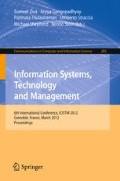Abstract
The modular exponentiation operation used in popular public key encryption schemes such as RSA, has been the focus of many side channel analysis (SCA) attacks in recent years. Current SCA attack countermeasures are largely static. Given sufficient signal to noise ratio and a number of power traces, static countermeasures can be defeated as they merely attempt to mask or hide the power consumption of the system under attack. This paper introduces a dynamic countermeasure which constantly varies the timing and power consumption of each operation, making correlation between traces more difficult than for static countermeasures.
Access this chapter
Tax calculation will be finalised at checkout
Purchases are for personal use only
Preview
Unable to display preview. Download preview PDF.
References
Kocher, P.C., Jaffe, J., Jun, B.: Differential Power Analysis. In: Wiener, M. (ed.) CRYPTO 1999. LNCS, vol. 1666, pp. 388–397. Springer, Heidelberg (1999)
Rivest, R.L., Shamir, A., Adleman, L.: A method for obtaining digital signatures and public-key cryptosystems. Commun. ACM 21, 120–126 (1978)
Mangard, S., Oswald, E., Popp, T.: Power Analysis Attacks: Revealing the Secrets of Smart Cards (Advances in Information Security). Springer-Verlag New York, Inc., Secaucus (2007)
Menezes, A.J., Oorschot, P.C.V., Vanstone, S.A., Rivest, R.L.: Handbook of Applied Cryptography (1997)
Nedjah, N., Mourelle, L.: Efficient hardware for modular exponentiation using the sliding-window method with variable-length partitioning. In: Proc. 9th Int. Conf. for Young Computer Scientists ICYCS 2008, pp. 1980–1985 (2008)
Booth, A.D.: A signed binary multiplication technique. The Quarterly Journal of Mechanics and Applied Mathematics 4(2), 236–240 (1951)
Daly, A., Marnane, W.: Efficient architectures for implementing montgomery modular multiplication and RSA modular exponentiation on reconfigurable logic. In: Proceedings of the 2002 ACM/SIGDA Tenth International Symposium on Field-Programmable Gate Arrays, FPGA 2002, New York, NY, USA, pp. 40–49. ACM (2002)
Montgomery, P.L.: Modular multiplication without trial division. Math. Computation 44, 519–521 (1985)
Patterson, D.A., Hennessy, J.L.: Computer organization & design: the hardware/software interface. Morgan Kaufmann Publishers Inc., San Francisco (1993)
Homma, N., Miyamoto, A., Aoki, T., Satoh, A., Samir, A.: Comparative power analysis of modular exponentiation algorithms. IEEE Trans. Comput. 59, 795–807 (2010)
Fouque, P.-A., Valette, F.: The Doubling Attack – Why Upwards Is Better than Downwards. In: Walter, C.D., Koç, Ç.K., Paar, C. (eds.) CHES 2003. LNCS, vol. 2779, pp. 269–280. Springer, Heidelberg (2003)
Yen, S.-M., Lien, W.-C., Moon, S.-J., Ha, J.C.: Power Analysis by Exploiting Chosen Message and Internal Collisions – Vulnerability of Checking Mechanism for RSA-Decryption. In: Dawson, E., Vaudenay, S. (eds.) Mycrypt 2005. LNCS, vol. 3715, pp. 183–195. Springer, Heidelberg (2005), doi:10.1007/11554868_13
Popp, T., Mangard, S.: Implementation aspects of the DPA-resistant logic style MDPL. In: Proc. IEEE Int. Symp. Circuits and Systems ISCAS (2006)
Ambrose, J.A., Parameswaran, S., Ignjatovic, A.: MUTE-AES: A multiprocessor architecture to prevent power analysis based side channel attack of the AES algorithm. In: IEEE/ACM International Conference on Computer-Aided Design, ICCAD 2008, pp. 678–684 (November 2008)
Sauvage, L., Guilley, S., Danger, J.-L., Mathieu, Y., Nassar, M.: Successful attack on an FPGA-based WDDL DES cryptoprocessor without place and route constraints. In: Design, Automation Test in Europe Conference Exhibition, DATE 2009, pp. 640–645 (April 2009)
Author information
Authors and Affiliations
Editor information
Editors and Affiliations
Rights and permissions
Copyright information
© 2012 Springer-Verlag Berlin Heidelberg
About this paper
Cite this paper
Barron, J., Andel, T.R., Kim, Y. (2012). Dynamic Architectural Countermeasure to Protect RSA against Side Channel Power Analysis Attacks. In: Dua, S., Gangopadhyay, A., Thulasiraman, P., Straccia, U., Shepherd, M., Stein, B. (eds) Information Systems, Technology and Management. ICISTM 2012. Communications in Computer and Information Science, vol 285. Springer, Berlin, Heidelberg. https://doi.org/10.1007/978-3-642-29166-1_33
Download citation
DOI: https://doi.org/10.1007/978-3-642-29166-1_33
Publisher Name: Springer, Berlin, Heidelberg
Print ISBN: 978-3-642-29165-4
Online ISBN: 978-3-642-29166-1
eBook Packages: Computer ScienceComputer Science (R0)

